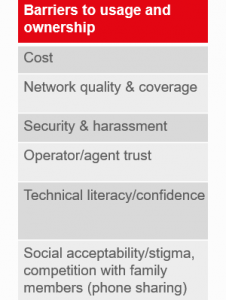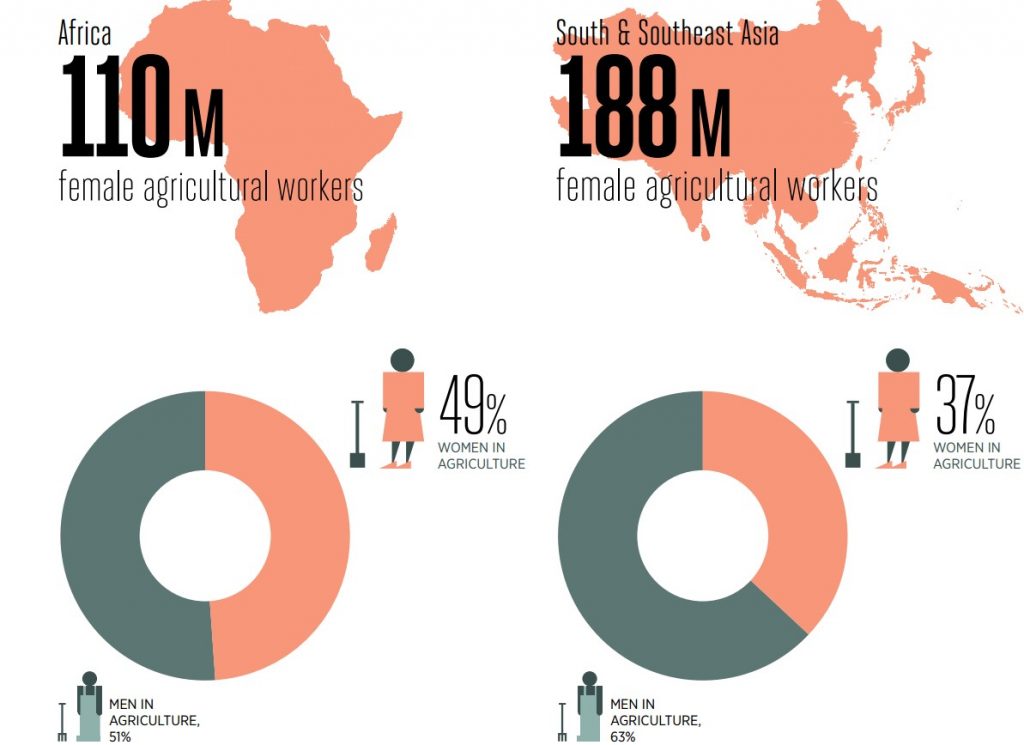Our mAgri programme supports scalable, commercial mobile services in improving the productivity and income of smallholder farmers and the agricultural sector in developing markets. As part of our ongoing research, we recognise the business and socio-economic opportunity in including all rural users and promoting the understanding of how to incorporate gender-sensitive practices throughout the product development cycle. Our mAgri programme learns from examples of effective practices that engage users, especially women, to help guide future planning and activities for mobile operators, as well as highlighting benefits of gender-inclusivity for providers of Agricultural Value-added Services (Agri VAS).
There is a major market opportunity for service providers in delivering mobile-enabled agricultural services (‘mAgri services’) to women. They offer economic benefits including an increased user base, as well as substantial social benefits such as: amplified leadership of women in decision making processes, female-influenced resource allocation, alternative use of land, finances and increased business opportunities within families, villages and communities in rural area. ‘The World Development Report 2012: Gender Equality and Development (World Bank, 2012c)’ argues that greater gender equality is not just the right thing to do but also smart economics. It highlights the need to improve the availability of quality gender-disaggregated data.
As the figure below indicates, women make up just under half of the total population of agricultural workers in Africa. Research has found that despite the figures portraying the proportion of women who play an active role in the processes and production of agriculture in emerging markets, there remains disparities in the representation of women farmers in the provision of Agri VAS.
Gender distribution of the agricultural labour force in target regions
Figure 1
In May 2014, our mAgri programme published the Women in Agriculture Toolkit for Mobile Services Practitioners as a response to a need from service providers wishing to improve their outreach to women and to create gender-sensitive services to reach rural female farmers.
Further research has since been carried out supporting the application of gender-centric design within the development of mAgri services in emerging markets. When considering making services more user friendly for women, providers have to consider a multitude of factors that continue to act as barriers impeding the potential influential role that women can play here.
Barriers facing women in the sector
As most of us know, the rights and status of women in many parts of the world remain unequal to men. In many states in Africa and Asia, women are unable to own a mobile phone due to affordability or ownership of one mobile phone for the whole family.
Other barriers include the network quality and coverage in rural areas being limited, weak and a cause of frustration. Women often experience harassment over their use of a mobile by their families or members of their community, they feel unsafe walking long distances to buy credit or charge their phone and may be an easy target for thieves. Other challenges include their literacy and technical ability being weak and therefore affecting their confidence in the use of a mobile.
Barriers to usage and ownership of mobiles for women in emerging markets
Figure 2
 The limiting factors shown in the table can have a knock-on effect on the accessibility of mAgri services for women and critical information on new farming techniques, weather forecasts, and appropriate crop production. It also inhibits the opportunity to access mobile money. Digital payments can reduce the time and cost associated with traditional cash disbursements by eliminating the need to travel long distances to receive and pay cash. Others face financial exclusion and in states where women cannot formally own land, this limits their opportunity to receive loans to invest in agriculture and form agricultural businesses. This inability to access credit can in turn act as a barrier for women to be considered for training, banking, and ownership of resources.
The limiting factors shown in the table can have a knock-on effect on the accessibility of mAgri services for women and critical information on new farming techniques, weather forecasts, and appropriate crop production. It also inhibits the opportunity to access mobile money. Digital payments can reduce the time and cost associated with traditional cash disbursements by eliminating the need to travel long distances to receive and pay cash. Others face financial exclusion and in states where women cannot formally own land, this limits their opportunity to receive loans to invest in agriculture and form agricultural businesses. This inability to access credit can in turn act as a barrier for women to be considered for training, banking, and ownership of resources.
Source: Adapted from GSMA. (2015) Bridging the gender gap: Mobile access and usage in low and middle-income countries, p.33, 42, 75
The benefits of gender inclusivity for mobile providers
As mobile penetration reaches the point of saturation in urban areas, rural markets represent high-growth opportunities for mobile operators seeking to reach new users. With rural female farmers having less access to mobile phones than men, yet an almost equal share of the agricultural labour force; rural women remain a huge market opportunity. GSMA Intelligence estimates the current Agri VAS potential market opportunity for women is 9.7 million subscribers in Sub-Saharan Africa, which could rise to 16.6 million in 2020 . With women comprising up to 50 per cent of agricultural workers in Africa, there is an estimated 556 million potential users globally (FAOSTAT 2013 estimate, includes Less Developed Countries in the Americas, Africa, and Asia (including China)). In providing a more tailored service, improved marketing and deeper understanding of customers, service providers can access rural female farmers and increase their user base.
How to create a gender inclusive service
The examples below are some of the ways in which service providers can implement the changes to their services necessary for gender inclusivity:
- Offer creative pricing that is sensitive towards the routines of women in rural areas of developing markets;
- Begin to launch marketing campaigns that illustrate the importance and benefits of women’s participation in services and target men in marketing campaigns in settings where they make decisions about women’s access;
- Build perceptions of mobile devices as a tool for information, a knowledge base and to increase the safety of women;
- Provide services that allow women to privately recharge their credit;
- Educate women on mobile safety, particularly if they are accessing services without prior male approval, for example, adding VAS OBD numbers under a ‘safe name’ such as “Farmer Information” which can avoid suspicion;
- Develop clear and transparent pricing;
- Make points of sale family friendly;
- When expanding agent networking, consider partnering with organisations that already have established and trusted networks with women;
- Employ user centric design principles, for example, ensuring the design of your service is based upon an explicit understanding of female and male users, their tasks and their environments;
- Engage local ambassadors and community leaders in the benefits of female user engagement; and
- Conduct consumer research to determine network quality and coverage and reasons why both quality and coverage is a greater barrier for women in agriculture (Source: Adapted from GSMA Connected Women. (2015) Bridging the gender gap report).
As we move further into 2017, we hope to see the future for female farmers evolving with the increased access of mobile phones, and from then onwards, the benefits of mAgri VAS in their agricultural processes.
We continue to work with mobile operators and associated stakeholders in identifying best practices and sharing key lessons to drive gender change in agricultural services.


